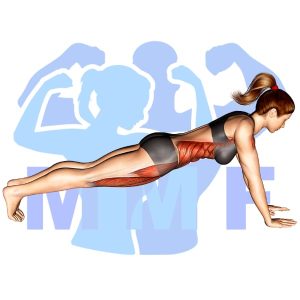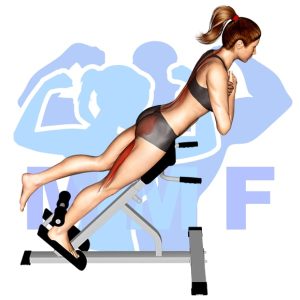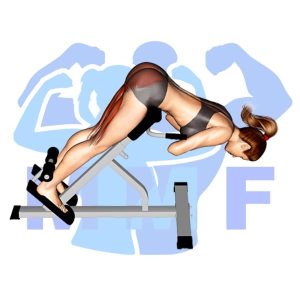Are you someone who experiences knee pain while attempting a bridge on knees? You’re not alone. As common as this issue is, it can still be frustrating and discouraging. The knee joint is one of the most used and sensitive joints in the body, which means there are a lot of potential causes for pain. But don’t worry, there is a solution to this problem. In this post, we’ll explore some common reasons why you may experience knee pain during a bridge, and provide you with tips to improve your technique and alleviate the discomfort.
Bridge (Plank) On Knees Summary
- Primary Muscles: Rectus Abdominis
- Secondary Muscles: Iliopsoas (Psoas Major & Iliacus), Obliques, Pectoralis major, Quadriceps, Sartorius, Serratus Anterior, Tensor Fasciae Latae, and Triceps
- Equipment: Body Weight
- Mechanics Type: Isolated
- Force: Pull
- Utility: Auxiliary

Bridge (Plank) On Knees Instructions
- Start off by laying face down on a flat surface.
- Push yourself onto your elbows and knees.
- Keep your body in line from your knees to the top of your head and hold.
Video Tutorial
Bridge (Plank) On Knees Muscles
Target (Agonist)
Synergists
- Iliopsoas (Psoas Major & Iliacus)
- Obliques
- Pectoralis major
- Quadriceps
- Sartorius
- Serratus Anterior
- Tensor Fasciae Latae
- Triceps
Dynamic Stabilizers
- None
Stabilizers
- None
Antagonist Stabilizers
- None

Benefits of Bridge (Plank) On Knees
The bridge on knees exercise is a great way to target the rectus abdominis muscle. This move requires you to start on your hands and knees, with your feet flat on the floor. You then contract your abs and lift your hips up off the ground, forming a bridge. As you do this, you should be sure to keep your core tight, your back straight, and your glutes engaged. This exercise is great for targeting the rectus abdominis, which is the large muscle that runs down the center of your abdomen. Performing this exercise regularly will help to strengthen and tone your abdominal muscles, while also helping to improve your overall core strength. Additionally, this exercise can help to improve posture, balance, and stability.
Tips for Performing Bridge (Plank) On Knees
You’ve come at the right location if you desire to advance your ability to conduct bridge on knees. These tips will get you more out of this amazing workout, while helping you receive all the benefits it has to offer. You’ll have the ability to tone your stomach muscles, and minimize your chance of getting hurt. It is time to begin and explore how these suggestions will benefit you.
- 1. Ensure your back is straight – Keeping your back straight while doing the Bridge On Knees exercise will help you maintain proper form and reduce the risk of injury. It will also ensure that you get the most out of your workout.
- 2. Keep your neck and head aligned – Aligning your neck and head properly while doing the Bridge On Knees exercise will help you keep your balance and ensure that you’re engaging the right muscles.
- 3. Activate your core – Activating your core muscles during the Bridge On Knees exercise will help you build strength and stability and maximize the effectiveness of the exercise.
Benefits and Tips Video
Frequent Mistakes To Avoid
Staying away from errors can mean the distinction between a successful training session and a painful injury when performing bridge on knees. Additionally, getting optimal results from this exercise requires appropriate form, and making sure you don’t perform typical errors can allow you to perform the exercise better and obtain your desired results. Not only can preventing these errors increase your strength, but also can assist in you feeling more confident and inspired when at in the gym. Let’s begin by avoiding these typical mistakes and add this exercise to your exercise regimen.
- 1. Not keeping the hips lifted: When performing the bridge on knees, it is important to keep the hips lifted off the ground in order to engage the right muscles and avoid putting too much pressure on the lower back. Not doing so can lead to strain and injury.
- 2. Keeping the feet too close together: When performing the bridge on knees, the feet should be positioned at hip-width apart to ensure proper stability and balance during the exercise. Keeping the feet too close together can lead to a loss of balance and an inability to get the most out of the exercise.
- 3. Not engaging the core muscles: Engaging your core muscles is key when doing the bridge on knees, as it helps to keep your body in proper alignment and allows you to get the most out of each repetition. Not engaging your core muscles can lead to a lack of stability and difficulty performing the exercise correctly.
Find More Bodyweight Exercises Here
Variations and Complementary Exercises
If you are looking for an alternative exercise to the Bridge On Knees, there are several variations, complementary, and alternative exercises that can help you work similar muscles. Below is a list of exercises that work similar muscles as the Bridge On Knees.
Bridge

Bridge is a great complementary or alternative exercise to Bridge On Knees. It can help to strengthen the glutes and core muscles, while also targeting the lower back. To do this exercise, you start by lying on your back with your feet flat on the floor and your knees bent. You then lift your hips up off the floor until your body forms a bridge shape with your head, shoulders, and feet all off the ground. This exercise can be made more challenging by adding a weight or holding the position for a few seconds. Bridge is an excellent exercise for strengthening your core and glutes, as well as improving balance and stability.
Bench Crunch

Bench crunches are an excellent complementary exercise to the bridge on knees, as they both target the core muscles. Bench crunches involve lying on a flat bench and using your abdominal muscles to lift your torso towards your knees. This exercise is similar to a crunch, but it engages the core more intensely due to the stability provided by the bench. The bridge on knees, on the other hand, works your core muscles by keeping your body in a bridge position while you lift your hips up and down with your knees bent. Both exercises help to build core strength, but bench crunches can provide an extra challenge due to the stability provided by the bench.
V Up

V Up is a great complementary or alternative exercise to Bridge On Knees. It works the same muscles as the Bridge On Knees, but instead of having your knees bent, you keep your legs extended straight out in front of you. To perform a V Up, start by lying on your back with your arms extended straight above your head. Then, slowly lift your upper body and legs off the ground at the same time, keeping your arms and legs straight. As you reach the top of the movement, hold for a few seconds before slowly returning back to the starting position. V Up is a great way to increase core strength and stability while still targeting the same muscles as Bridge On Knees.
Check Out These Top Bodyweight Exercises
Straight Arm Crunch

The Straight Arm Crunch is a great complement or alternative to the exercise Bridge On Knees. It is a simple yet effective exercise that works the abdominal muscles, hip flexors, and obliques. To perform this exercise, you simply lie on your back with your legs bent and feet flat on the floor. Next, extend your arms straight up towards the ceiling and slowly crunch your torso up towards your knees. This works the entire core and can be done for several repetitions for an intense abdominal workout.
Straight Arm Bridge

The Straight Arm Bridge is a great complementary or alternative exercise to the Bridge On Knees. It is performed in a similar way, except with arms straight and parallel to the ground, instead of bent at the elbows. This exercise works the muscles in the glutes and hamstrings, as well as the lower back. Additionally, it can be used to build strength and stability in the core and upper body. Unlike the Bridge On Knees, which focuses primarily on glute activation, the Straight Arm Bridge requires more effort from the entire body. As such, it can provide an effective full-body workout that increases strength and flexibility.
Standard Crunch

Standard Crunch is a complementary exercise to Bridge On Knees and is an excellent alternative for those who are looking to increase the intensity of their workout. The Standard Crunch involves lying flat on your back with your knees bent and your feet flat on the floor. From this position, you then lift your upper body off the floor and crunch your abs before returning to the starting position. This exercise is great for strengthening the abdominal muscles and also works to tone the hips, back, and arms. It is an excellent way to add variety to your workout routine and is an ideal complement to Bridge On Knees.
Find More Abs Exercises Here
Opposing Complementary Exercises
In addition to Bridge On Knees, there are other exercises that can be used to complement the exercise and help to strengthen opposing muscle groups. These exercises will help to create a balanced workout routine that will maximize the benefits of the Bridge On Knees exercise. Here are some exercises that can be used to complement the Bridge On Knees exercise:
45 Degree One Leg Hyperextension

The 45 Degree One Leg Hyperextension is an excellent exercise to strengthen the lower back and gluteal muscles. It works by having the user lean forward at a 45 degree angle, with one leg on the floor and the other extended out behind them. This exercise is complementary to the Bridge On Knees exercise, as it works the opposing muscle group of the hamstrings and glutes. The 45 Degree One Leg Hyperextension helps to build strength in the lower back and also helps to increase flexibility in the hips and hamstrings. This exercise is beneficial for improving posture and reducing lower back pain.
45 Degree Hyperextension

The 45 Degree Hyperextension is an excellent exercise for strengthening the back muscles and is complementary to the Bridge On Knees exercise. It works the opposing muscle group, the lower back, and is a great way to strengthen the entire back area. The 45 Degree Hyperextension requires you to lay on your stomach on a bench and then raise your legs up so that your body forms a 90 degree angle. This exercise helps to build lower back strength, stability and flexibility. The Bridge On Knees exercise is a great way to strengthen the upper back muscles and is complementary to the 45 Degree Hyperextension as it targets the opposing muscle group. This exercise requires you to be on your hands and knees, with your knees bent and then slowly lift your hips off the floor while keeping your back in a straight line. This exercise helps to strengthen and stabilize the upper back and shoulders. By performing both of these exercises together, you will be able to strengthen your entire back area and improve your posture.
Straight Leg Cable Pull Through

The Straight Leg Cable Pull Through is a great complementary exercise to the Bridge On Knees. It works the opposing muscle group and helps to build strength and stability in the lower back and glutes. This exercise involves standing with feet hip-width apart and holding a cable handle between the legs. The hips are then pushed back as you lower the cable handle towards the floor, and then pushed forward as you pull the cable back up towards your chest. The focus should be on keeping your core tight and using your glutes to power through the motion. This exercise helps strengthen and stabilize the lower back, hips, and glutes, which makes it a great complement to the Bridge On Knees, which focuses on strengthening and stabilizing the core muscles.
Get Your Glutes in Shape with Knee Bridges
Are you looking to tone your glutes and thighs? Look no further than knee bridges! This exercise is great for activating your glutes and building strength in your lower body. Knee bridges are performed with your feet on the ground, allowing you to focus on engaging your glutes without putting pressure on your back. With just a few sets of knee bridges a week, you’ll start to notice a difference in the shape and size of your glutes. Incorporate knee bridges into your workout routine for a simple but effective way to sculpt your lower body.
References: Wikipedia | ExRx.net | PubMed.gov | Comprehensive List of Abs Bodyweight Exercises

